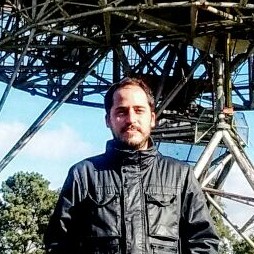Research


About PuMA
First pulsar observations in South America
PuMa, Pulsar Monitoring in Argentina, is a scientific collaboration dedicated to pulsar observation from the south hemisphere. The team, integrated by scientist and technicians from the Argentine Institute of Radioastronomy (IAR) and the Rochester Institute of Technolgy (RIT), is currently working with the two 30 meters single-dish radio antennas in the Institute. Our main goal is to perform long-term observational campaign of pulsars -rapidly-rotating and highly-magnetized neutron stars- to gain a better understanding of their nature. In particular, we observe milisecond pulsars used in pulsar timing arrays and glitching pulsars.
Papers published in international journals
Glitch-induced pulse profile change of PSR J0742−2822 observed from the IARE. Zubieta, F. García, S. del Palacio, C. M. Espinoza, S. B. Araujo Furlan, G. Gancio, C. O. Lousto, J. A. Combi and E. Gügercinoğlu.
Timing irregularities and glitches from the pulsar monitoring campaign at IARE. Zubieta, F. García, S. del Palacio, S. B. Araujo Furlan, G. Gancio, C. O. Lousto, J. A. Combi, and C. M. Espinoza.
First results of the glitching pulsars monitoring program at the Argentine Institute of RadioastronomyEzequiel Zubieta, Ryan Missel, Valentina Sosa Fiscella, Carlos O. Lousto, Santiago del Palacio, Federico G. López Armengol, Federico García, Jorge A. Combi, Linwei Wang, Luciano Combi, Guillermo Gancio, Carolina Negrelli and Eduardo M. Gutiérrez.
Vela pulsar: single pulses analysis with machine learning techniquesCarlos O Lousto, Ryan Missel, Harshkumar Prajapati, Valentina Sosa Fiscella, Federico G López Armengol, Prashnna Kumar Gyawali, Linwei Wang, Nathan D Cahill, Luciano Combi, Santiago del Palacio, Jorge A Combi, Guillermo Gancio, Federico García, Eduardo M Gutiérrez and Fernando Hauscarriaga.
PSR J0437-4715: The Argentine Institute of Radioastronomy 2019–2020 Observational CampaignV. Sosa Fiscella, S. del Palacio, L. Combi, C. O. Lousto, J. A. Combi, G. Gancio, F. García, E. Gutiérrez, F. Hauscarriaga, P. Kornecki, F. G. López Armengol, G. C. Mancuso, A. L. Müller and A. Simaz Bunzel.
Upgraded antennas for pulsar observations in the Argentine Institute of Radio astronomyG. Gancio, C.O. Lousto, L. Combi, S. del Palacio, F.G. López Armengol, J.A. Combi, F. García, P. Kornecki, A.L. Müller, E. Gutierrez, F. Hauscarriaga and G. C.Mancuso.
Proceedings
Updates on the Glitching Pulsar Monitoring Campaign Performed from IARZubieta, E. ; del Palacio, S. ; García, F. ; Araujo Furlan, S. B. search by orcid ; Gancio, G. ; Lousto, C. O. and Combi, J. A.
Prospects for Detecting Fast Transients with the Radio Telescopes of the Argentine Institute of Radio AstronomyAraujo Furlan, Susana Beatriz; Zubieta, Ezequiel ; Gancio, Guillermo ; Esteban Romero, Gustavo ; del Palacio, Santiago ; García, Federico search by orcid ; Lousto, Carlos Oscar and Combi, Jorge Ariel
Pulsar Observations at low latitudes and low frequenciesCarlos O. Lousto, R. Missel, E. Zubieta, S. del Palacio, F. Garcia, G. Gancio, L. Wang, S.B. Araujo Furlan and J.A. Combi
Telegrams
Detection of a new giant glitch in the Vela Pulsar observed from the Argentine Institute of Radio astronomyATel #16608; E. Zubieta, S. B. Araujo Furlan, S. del Palacio, F. Garcia, G. Gancio, C. O. Lousto, J. A. Combi, on behalf of the PuMA Collaboration.
Detection of a new glitch in PSR J1048-5832 observed from the Argentine Institute of Radio astronomyATel #16580; E. Zubieta, S. B. Araujo Furlan, S. del Palacio, F. Garcia, G. Gancio, C. O. Lousto, J. A. Combi, on behalf of the PuMA Collaboration.
Detection of a new glitch in the pulsar PSR J1740-3015Detection of a new glitch in the pulsar PSR J1740-3015ATel #15838; E. Zubieta, S. B. Araujo Furlan, S. del Palacio, F. Garcia, G. Gancio, C. O. Lousto, J. A. Combi, L. Combi, on behalf of the PuMA Collaboration.
Confirmation of glitch event observed in PSR J0742-2822 at the Argentine Institute of Radioastronomy (IAR)ATel #15638; E. Zubieta, S. del Palacio, F. Garcia, G. Gancio, C. O. Lousto, J. A. Combi, L. Combi, E. Gutierrez, F. A. Lopez-Armengol, A. Simaz Bunzel, V. Sosa-Fiscella, on behalf of the PuMA Collaboration.
A new Glitch in the Vela Pulsar (PSR B0833-45/PSR J0835-4510)ATel #14806; V. Sosa-Fiscella, E. Zubieta, S. del Palacio, F. Garcia, F. A. Lopez-Armengol, J. A. Combi, C. O. Lousto, G. Gancio, L. Combi, E. Gutierrez, A. Simaz Bunzel, F. Hauscarriaga, on behalf of the PuMA Collaboration.
Follow up of the radio flare from the magnetar XTE J1810-197 at 1.4 GHzATel #12323; S. del Palacio, F. Garcia, L. Combi, F. Lopez Armengol, G. Gancio, A. L. Muller, P. Kornecki,on behalf of the PuMA Collaboration.










